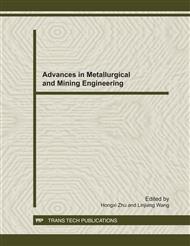[1]
W.J. Tomlinson, R. Rushton, R. Cindery, S. Palmer, Anodic Polarization and Corrosion of Vanadium, and V-Ta, V-W, V-Cr and V-Cr-W Alloys in 10-Percent H2SO4 and 3-Percent Nacl in Water, J Less-Common Met 132 (1987) L1-L4.
DOI: 10.1016/0022-5088(87)90185-8
Google Scholar
[2]
F.M. Al-Kharafi, W.A. Badawy, Electrochemical behaviour of vanadium in aqueous solutions of different pH, Electrochimica acta 42 (1997) 579-586.
DOI: 10.1016/s0013-4686(96)00202-2
Google Scholar
[3]
R. Armstrong, M. Henderson, The anodic dissolution of vanadium in acid solutions, Journal of Electroanalytical Chemistry and Interfacial Electrochemistry 26 (1970) 381-386.
DOI: 10.1016/s0022-0728(70)80320-5
Google Scholar
[4]
C. Ponce de Leon, A. Frias-Ferrer, J. Gonzalez-Garcia, D. Szanto, F.C. Walsh, Redox flow cells for energy conversion, Journal of power sources 160 (2006) 716-732.
DOI: 10.1016/j.jpowsour.2006.02.095
Google Scholar
[5]
M. Privman, T. Hepel, Electrochemistry of vanadium electrodes Part 1. Cyclic voltammetry in aqueous solutions, J. Electroanal. Chem. 382 (1995) 137-144.
DOI: 10.1016/0022-0728(94)03633-e
Google Scholar
[6]
M. Privman, T. Hepel, Electrochemistry of vanadium electrodes Part 2. Anodic and cathodic polarization over a wide range of pH and temperature, J. Electroanal. Chem. 382 (1995) 145-152.
DOI: 10.1016/0022-0728(94)03634-f
Google Scholar
[7]
E. Sum, M. Rychcik, M. Skyllas-kazacos, Investigation of the V(V)/V(IV) system for use in the positive half-cell of a redox battery, Journal of power sources 16 (1985) 85-95.
DOI: 10.1016/0378-7753(85)80082-3
Google Scholar
[8]
E. Sum, M. Skyllaskazacos, A Study of the V(Ⅱ)/V(Ⅲ) Redox Couple for Redox Flow Cell Applications, Journal of power sources 15 (1985) 179-190.
DOI: 10.1016/0378-7753(85)80071-9
Google Scholar
[9]
E. Barrado, R. Pardo, Y. Castrillejo, M. Vega, Electrochemical behaviour of vanadium compounds at a carbon paste electrode, J. Electroanal. Chem. 427 (1997) 35-42.
DOI: 10.1016/s0022-0728(96)05041-3
Google Scholar
[10]
A.S. Doncharenko, O.A. Suvorova, Zh. Prikl. Khim. 35 (1960) 846-849.
Google Scholar
[11]
J. Li, J. Du, J. Lu, Flow injection electrogenerated chemiluminescence determination of vanadium and its application to environmental water sample, Talanta 57 (2002) 53-57.
DOI: 10.1016/s0039-9140(02)00004-8
Google Scholar
[12]
E.G. Shirinov, Z.G. Gasanly, D.M. Ganbarov, Reduction of Vanadium from Alkaline Solutions, Russ. J. Appl. Chem. 82 (2009) 1230-1233.
DOI: 10.1134/s1070427209070131
Google Scholar
[13]
M. Stackelberg, P. Klinger, W. Koch, E. Krath, Polarographic determination of the alloying constituents in alloy steels, Forschungsber. Tech. Mitt. Krupp 2 (1939) 59.
Google Scholar
[14]
J.J. Lingane, Polarographic Characteristics of Vanadium in Its Various Oxidation States, J. Am. Chem. Soc. 67 (1945) 182-188.
DOI: 10.1021/ja01218a009
Google Scholar
[15]
T. Jedral, Z. Galus, Electrochemical Processes of Vanadium Ions .2. Mechanism of Electroreduction of Vanadium(V) in Its Moderately Concentrated Solutions in Presence of Ammonia, Rocz Chem 44 (1970) 2015-&.
DOI: 10.1002/chin.197509035
Google Scholar
[16]
T. Jedral, Z. Galus, Electrochemical Processes of Vanadium Ions .1. Mechanism of Electroreduction of Vanadium(V) in Its Diluted Solutions in Presence of Ammonia, Rocz Chem 44 (1970) 1517-&.
DOI: 10.1002/chin.197509035
Google Scholar
[17]
R.W. Schmidt, C.N. Reilly, ibid. 80 (1958) 2087.
Google Scholar
[18]
B. Zeltzer, ibid. 4 (1932) 319.
Google Scholar
[19]
B. Liu, S. Zheng, S. Wang, Y. Zhang, A. Ortega, N.S. Kim, K. Han, H. Du, Investigation of the Redox Behavior of Vanadium in Alkaline Solutions by Cyclic Voltammetry, Electrochimica Acta (2011).
DOI: 10.1016/j.electacta.2012.05.008
Google Scholar
[20]
L.G. Hepler, J.O. Hill, I.G. Worsley, Thermochemistry and oxidation potentials of vanadium, niobium, and tantalum, Chemical Reviews 71 (1971) 127-137.
DOI: 10.1021/cr60269a006
Google Scholar
[21]
A.J. Bard, J. Ketelaar, Encyclopedia of Electrochemistry of the Elements, New York, 1978.
Google Scholar
[22]
G. Thanheiser, J. Willems, Arch. Eisenhuettenw. 13 (1939) 73.
Google Scholar
[23]
R.M. Abouatallah, D.W. Kirk, S.J. Thorpe, J.W. Graydon, Characterization of vanadium deposit formation at a hydrogen evolving electrode in alkaline media, Journal of The Electrochemical Society 148 (2001) E357-E363.
DOI: 10.1149/1.1386385
Google Scholar


